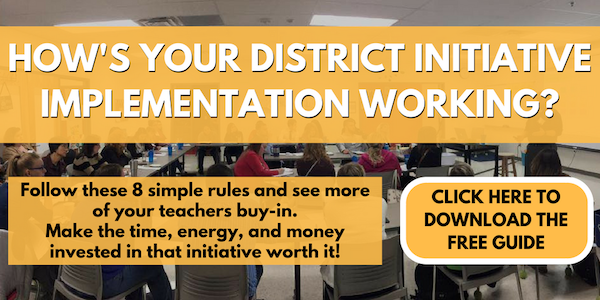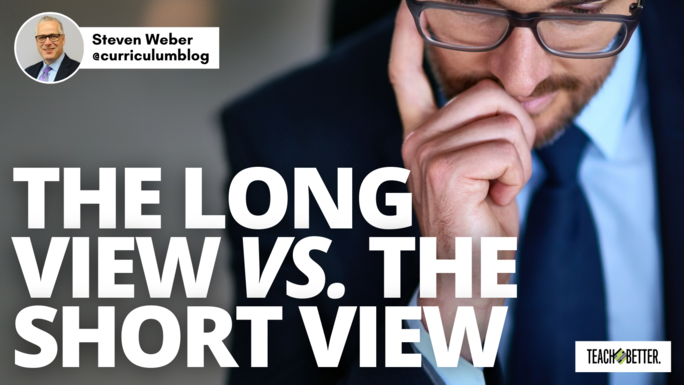TL;DR:
- Navigating a crisis requires a short view. It is time to refocus on the long view.
- In order to focus on the long view, educators need to begin with the end in mind, create a guiding coalition, identify a strategy for the first weeks of school, and focus on systems work vs. patchwork.
“Leading through a crisis requires taking the long view, as opposed to managing the present. You need to anticipate what comes next week, next month, and even next year in order to prepare the organization for the changes ahead” (McNulty and Marcus, 2020).
Leadership requires a vision of a destination, with mile markers throughout the journey. During the pandemic, school teams shifted their focus to daily and weekly decisions. District meetings and school leaders may have addressed social distancing, COVID dashboard data, virtual learning, board policies, instructional strategies, and communication. Navigating a crisis requires a short view. Survival and charting a course through uncertainty take the focus away from long-term planning and forces leaders to develop a plan for today. As school teams begin to plan for the 2021-22 school year, it is time to refocus on the long view.
The success of schools will depend on guiding coalitions that reflect on the end in mind, identify strategies for supporting students and staff, and focus on systems work. Click To TweetIn order to take the long view, educators will need to:
Begin With the End in Mind
Does your school team have a goal to support social and emotional learning? Several school districts begin by searching for a program or a kit. It would be more beneficial if educators identified the desired outcomes. Which skills do we want students to develop in this grade level or course? How will we know that SEL has been effectively implemented by the end of the school year? What professional development do teachers and staff need in order to successfully implement social and emotional learning? How can we make SEL part of our instruction, rather than an add-on or weekly activity?
What changes do we need to make in order to reach the desired outcomes of an effective SEL program? Backward design “reminds us to begin with the question, ‘What would we accept as evidence that students have attained the desired understandings and proficiencies?’ – before proceeding to plan teaching and learning experiences” (Wiggins and McTighe, 1998).
Create a Guiding Coalition
School leadership requires a guiding coalition. Most schools have a student council, parent-teacher organization, curriculum leadership team, RtI or MTSS team, or a reopening schools task force. In the absence of a guiding coalition, a principal will lack multiple perspectives and the recommendations that are necessary for taking the long view.
Who needs to serve on your school or district level guiding coalition? What questions are you asking about the long view and the needs of students and staff in a post-pandemic school? A guiding coalition “defines what the future should look like, aligns people with that vision, and inspires them to make it happen despite the obstacles” (Kotter, 2012, p. 28).
Identify a Strategy
“While most organizations have a plan, few of them have a strategy. A plan is just an account of who will do what and when. By contrast, a strategy is a tight, cogent set of ideas about how best to fulfill the mission of the organization” (Stevenson, 2019). In order to support teaching and learning, school teams will need a strategy. Too often, planning meetings result in ‘To Do Lists’ and ‘Next Steps.’
Rather than creating additional lists, it is wise to develop a strategy for the first five weeks of school. What are the key skills that teachers will teach or review? Which routines will a first grader need to learn, since thousands of first graders experienced their kindergarten year as a virtual student? How will we identify students who need additional non-academic support? What are the plans for supporting students with social skills after one year of social distancing, isolation, and wearing masks? A strategy will support the educators who are seeking small wins in August and September. One way to identify a back-to-school strategy is by asking, “What does a small win in August look like?”
Focus on Systems Work vs. Patchwork
The pandemic highlighted gaps in the existing system. School teams noticed areas in the school or school system that need to be addressed and may have been overlooked for several years. When school teams take the short view, it is akin to patching up a hole or a ‘quick fix.’ “We tend to focus on snapshots of isolated parts of the system, and wonder why our deepest problems never seem to get solved” (Senge, 1990).
When schools closed, technology and Internet access were barriers for students and families. Some schools had a digital learning platform prior to the pandemic, while other schools in the same district were struggling to upload daily lessons, videos, and assignments. School staff immediately noticed how the grading system rewarded students who completed homework or who had access to high-speed Internet, while penalizing students who needed additional time or access to wifi.
As schools reopen for onsite instruction, there will be a need for mental health services, social and emotional learning, academic interventions, credit recovery, reading instruction, and school clubs. The way educators approach systems work will be critically important in meeting the needs of learners.
[scroll down to keep reading]
Conclusion
The future of education is uncertain. Students, families, and educators are depending on schools to help communities recover. Education has been the one constant throughout turbulent times, a changing economy, new demands for the workforce, wars, natural disasters, and global pandemics.
The success of schools will depend on guiding coalitions that reflect on the end in mind, identify strategies for supporting students and staff, and focus on systems work. “Plan to adjust and have systems in place for proactively getting and using feedback to make timely and effective adjustments, early and often. No educator can predict the future” (Wiggins and McTighe, 2007). Focusing on a ‘return to normal’ will not address the complex needs of students, staff, and school. School teams should take the long view and begin building a system that meets the needs of all learners.
References
Kotter, J.P. (2012). Leading change. Harvard Business Review Press.
McNulty, E.J., & Marcus, L. (2020). Are you leading through the crisis … or managing the response? Harvard Business Review. https://hbr.org/2020/03/are-you-leading-through-the-crisis-or-managing-the-response
Senge, P. (1990). The fifth discipline: The art and practice of the learning organization. Doubleday/Currency.
Stevenson, I. (2019). An improvement plan is not enough — you need a strategy. Phi Delta Kappan, 100 (6), 60-64. https://kappanonline.org/school-improvement-plan-not-enough-you-need-strategy-stevenson/#:~:text=A%20plan%20is%20just%20an,take%20to%20do%20so%20successfully
Wiggins, G., & McTighe, J. (1998). Understanding by design. ASCD.
Wiggins, G., & McTighe, J. (2007). Schooling by design. ASCD.
About Steven Weber
Dr. Steven Weber is the Associate Superintendent for Teaching and Learning with Fayetteville Public Schools (AR). His areas of research include curriculum design, formative assessment, professional learning, and school leadership.



